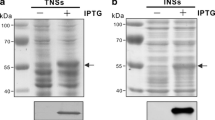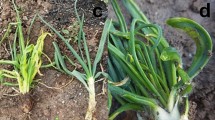Abstract
Melon yellow spot virus (MYSV), a tentative member of the genus Tospovirus, is considered a distinct serotype due to the lack of a serological relationship with other tospoviruses in its nucleocapsid protein (NP). Recently, a virus isolate collected from diseased watermelon in central Taiwan (MYSV-TW) was found to react with a rabbit antiserum (RAs) prepared against the NP of Watermelon silver mottle virus (WSMoV), and a monoclonal antibody (MAb) prepared against the common epitope of the NSs proteins of WSMoV-serogroup tospoviruses, but not with the WSMoV NP-specific MAb, in both enzyme-linked immunosorbent assay (ELISA) and western blotting. In this investigation, both RAs and MAb against MYSV-TW NP were produced. Results of serological tests revealed that the RAs to MYSV-TW NP reacted with the homologous antigen and the crude antigens of members of the WSMoV serogroup, including members of the formal species WSMoV and Peanut bud necrosis virus, and members of three tentative species, Watermelon bud necrosis virus, Capsicum chlorosis virus and Calla lily chlorotic spot virus. The MAb to MYSV-TW NP reacted only with the homologous antigen and the other geographic isolates of MYSV from Japan (JP) and Thailand (TH). Our results of reciprocal tests indicate that the NP and the NSs protein of MYSV are serologically related to those of WSMoV-serogroup tospoviruses. Furthermore, we show that both the MYSV NP MAb and the WSMoV NP MAb are reliable tools for identification of MYSV and WSMoV from single or mixed infection in field surveys, as verified using species-specific primers in reverse transcription-polymerase chain reaction.





Similar content being viewed by others
References
Adams MJ, Antoniw JF, Fauquet CM (2005) Molecular criteria for genus and species discrimination within the family Potyviridae. Arch Virol 150:459–479
Bucher E, Sijen T, de Haan P, Goldbach R, Prins M (2003) Negative-strand tospoviruses and tenuiviruses carry a gene for a suppressor of gene silencing at analogous genomic positions. J Virol 77:1329–1336
Chen CC, Chen TC, Lin YH, Yeh SD, Hsu HT (2005) A chlorotic spot disease on calla lilies (Zantedeschia spp.) is caused by a tospovirus serologically but distantly related to Watermelon silver mottle virus. Plant Dis 89:440–445
Chen CC, Huang CH, Chen TC, Yeh SD, Cheng YH, Hsu HT, Chang CA (2007) First report of Capsicum chlorosis virus caused yellowing stripes on calla lilies. Plant Dis 91:1201
Chen CC, Shy JF, Yeh SD (1990) Thrips transmission of Tomato spotted wilt virus from watermelon. Plant Prot Bull 32:331–332
Chen TC, Hsu HT, Jain RK, Huang CW, Lin CH, Liu FL, Yeh SD (2005) Purification and serological analyses of tospoviral nucleocapsid proteins expressed by Zucchini yellow mosaic virus vector in squash. J Virol Methods 129:113–124
Chen TC, Huang CW, Kuo YW, Liu FL, Hsuan Yuan CH, Hsu HT, Yeh SD (2006) Identification of common epitopes on a conserved region of NSs proteins among tospoviruses of Watermelon silver mottle virus serogroup. Phytopathology 96:1296–1304
Chen TC, Lu YY, Cheng YH, Chang CA, Yeh SD (2008) Melon yellow spot virus in watermelon: a first record from Taiwan. Plant Pathol 57:765
Chiemsombat P, Gajanandana O, Warin N, Hongprayoon R, Bhunchoth A, Pongsapich P (2008) Biological and molecular characterization of tospoviruses in Thailand. Arch Virol 153:571–577
Chu FH, Chao CH, Peng YC, Lin SS, Chen CC, Yeh SD (2001) Serological and molecular characterization of Peanut chlorotic fan-spot virus, a new species of the genus Tospovirus. Phytopathology 91:856–863
Ciuffo M, Kurowski C, Vivoda E, Copes B, Masenga V, Falk BW, Turina M (2009) A new Tospovirus sp. in cucurbit crops in Mexico. Plant Dis 93:467–474
Ciuffo M, Tavella L, Pacifico D, Masenga V, Turina M (2008) A member of a new Tospovirus species isolated in Italy from wild buckwheat (Polygonum convolvulus). Arch Virol 153:2059–2068
Cortes I, Livieratos IC, Derks A, Peters D, Kormelink R (1998) Molecular and serological characterization of Iris yellow spot virus, a new and distinct tospovirus species. Phytopathology 88:1276–1282
Cortes I, Saaijer J, Wongjkaew KS, Pereira AM, Goldbach R, Peters D, Kormelink R (2001) Identification and characterization of a novel tospovirus species using a new RT-PCR approach. Arch Virol 146:265–278
de Haan P, Kormelink R, RdeO Resende, van Poelwijk F, Peters D, Goldbach R (1991) Tomato spotted wilt virus L RNA encodes a putative RNA polymerase. J Gen Virol 71:2207–2216
de Haan P, Wagemakers L, Peters D, Goldbach RW (1990) The S RNA segment of Tomato spotted wilt virus has an ambisense character. J Gen Virol 71:1001–1007
Dong JH, Cheng XF, Yin YY, Fang Q, Ding M, Li TT, Zhang LZ, Su XX, McBeath JH, Zhang ZK (2008) Characterization of tomato zonate spot virus, a new tospovirus in China. Arch Virol 153:855–864
Fauquet CM, Mayo MA, Maniloff J, Desselberger U, Ball LA (2005) Virus taxonomy: Eighth report of the international committee on taxonomy of viruses. Elsevier/Academic Press, San Diego, CA
Goldbach R, Kuo G (1996) Introduction: Proceedings of the international symposium on tospovirus and thrips of floral and vegetable crops. Acta Hortic 431:21–26
Gooderham K (1984) Transfer techniques in protein blotting. In: Walker JM (ed) Methods in molecular biology, vol 1. Proteins. Humana Press, Clifton, pp 165–178
Hassani-Mehraban A, Botermans M, Verhoeven JTJ, Meekes E, Saaijer J, Peters D, Goldbach R, Kormelink R (2010) A distinct tospovirus causing necrotic streak on Alstroemeria sp. in Colombia. Arch Virol 155:423–428
Hassani-Mehraban A, Saaijer J, Peters D, Goldbach R, Kormelink R (2007) Molecular and biological comparison of two Tomato yellow ring virus (TYRV) isolates: challenging the Tospovirus species concept. Arch Virol 152:85–96
Heinze C, Letschert B, Hristova D, Yankulova M, Kauadjouor O, Willingmann P, Atanassov A, Adam G (2001) Variability of the N-protein and the intergenic region of the S RNA of tomato spotted wilt tospovirus (TSWV). New Microbiol 24:175–187
Heinze C, Willingmann P, Schwach F, Adam G (2003) An unusual large intergenic region in the S-RNA of a Bulgarian tomato spotted wilt virus isolate. Arch Virol 148:199–205
Hsu HT, Aebig J, Rochow WF (1984) Differences among monoclonal antibodies to Barley yellow dwarf viruses. Phytopathology 74:600–605
Hsu HT, Ueng PP, Chu FH, Ye Z, Yeh SD (2000) Serological and molecular characterization of a high temperature-recovered virus belonging to Tospovirus serogroup IV. J Gen Plant Pathol 66:167–175
Jan FJ, Chen TC, Yeh SD (2003) Occurrence, importance, taxonomy, and control of thrips-borne tospoviruses. In: Huang HC, Acharya SN (eds) Advances in plant disease management. Research Signpost, Trivandrum, India, pp 391–411
Kato K, Hanada K, Kameya-Iwaki M (1999) Transmissions mode, host range and electron microscopy of a pathogen causing a new disease of melon (Cucumis melo) in Japan. Ann Phytopathol Soc Jpn 65:624–627
Kato K, Hanada K, Kameya-Iwaki M (2000) Melon yellow spot virus: a distinct species of the genus Tospovirus isolated from melon. Phytopathology 90:422–426
Knierim D, Blawid R, Maiss E (2006) The complete nucleotide sequence of a capsicum chlorosis virus isolate from Lycopersicum esculentum in Thailand. Arch Virol 151:1761–1782
Kormelink R, de Haan P, Meurs C, Peters D, Goldbach R (1992) The nucleotide sequence of the M RNA segment of Tomato spotted wilt virus, a bunyavirus with two ambisense RNA segments. J Gen Virol 73:2795–2804
Kormelink R, Kitajima EW, de Haan P, Zuidema D, Peters D, Goldbach R (1991) The nonstructural protein (NSs) encoded by the ambisense S RNA segment of Tomato spotted wilt virus is associated with fibrous structures in infected plant cells. Virology 181:459–468
Kormelink R, Storms M, Van Lent J, Peters D, Goldbach R (1994) Expression and subcellular location of the NSm protein of Tomato spotted wilt virus (TSWV), a putative viral movement protein. Virology 200:56–65
Law MD, Moyer JW (1990) A tomato spotted wilt-like virus with a serologically distinct N protein. J Gen Virol 71:933–938
Law MD, Speck J, Moyer JW (1992) The M RNA of Impatiens necrotic spot tospovirus (Bunyaviridae) has an ambisense genomic organization. Virology 188:732–741
Lewandowski DJ, Adkins S (2005) The tubule-forming NSm protein from Tomato spotted wilt virus complements cell-to-cell and long-distance movement of Tobacco mosaic virus hybrids. Virology 342:26–37
Lin YH, Chen TC, Hsu HT, Liu FL, Chu FH, Chen CC, Lin YZ, Yeh SD (2005) Serological comparison and molecular characterization for verification of Calla lily chlorotic spot virus as a new tospovirus species belonging to Watermelon silver mottle virus serogroup. Phytopathology 95:1482–1488
Margaria P, Ciuffo M, Pacifico D, Turina M (2007) Evidence that the nonstructural protein of Tomato spotted wilt virus is the avirulence determinant in the interaction with resistant pepper carrying the Tsw gene. Mol Plant Microbe Interact 20:547–558
Okuda M, Takeuchi S, Taba S, Kato K, Hanada K (2002) Melon yellow spot virus and Watermelon silver mottle virus: outbreak of cucurbit infecting tospovirus in Japan. Acta Hortic 588:143–148
Pang SZ, Slightom JL, Gonsalves D (1993) The biological properties of a distinct tospovirus and sequence analysis of its S RNA. Phytopathology 83:728–733
Pappu SS, Bhat AI, Pappu HR, Deom CM, Culbreath AK (2000) Phylogenetic studies of tospoviruses (Family: Bunyaviridae) based on intergenic region sequence of small and medium genomic RNAs. Arch Virol 145:1035–1045
Satyanarayana T, Gowda S, Reddy KL, Mitchell SE, Dawson WO, Reddy DVR (1998) Peanut yellow spot virus is a member of a new serogroup of Tospovirus genus based on small (S) RNA sequence and organization. Arch Virol 143:353–364
Schaefer BC (1995) Revolutions in rapid amplification of cDNA ends: new strategies for polymerase chain reaction cloning of full-length cDNA ends. Anal Biochem 227:255–273
Takeda A, Sugiyama K, Nagano H, Mori M, Kaido M, Mise K, Tsuda S, Okuno T (2002) Identification of a novel RNA silencing suppressor, NSs protein of Tomato spotted wilt virus. FEBS Lett 532:75–79
Yeh SD, Chang TF (1995) Nucleotide sequence of the N gene of Watermelon silver mottle virus, a proposed new member of the genus Tospovirus. Phytopathology 85:58–64
Yeh SD, Chao CH, Cheng YH, Chen CC (1996) Serological comparison of four distinct tospoviruses by polyclonal antibodies to purified nucleocapsid proteins. Acta Hortic 431:122–134
Yeh SD, Gonsalves D (1984) Purification and immunological analyses of cylindrical-inclusion protein induced by Papaya ringspot virus and Watermelon mosaic virus 1. Phytopathology 74:1273–1278
Yeh SD, Gonsalves D, Provvidenti R (1984) Comparative studies on host range and serology of Papaya ringspot virus and Watermelon mosaic virus 1. Phytopathology 74:1081–1085
Yeh SD, Lin YC, Cheng YH, Jih CL, Chen MJ, Chen CC (1992) Identification of tomato spotted wilt-like virus infecting watermelon in Taiwan. Plant Dis 76:835–840
Zheng YX, Chen CC, Yang CJ, Yeh SD, Jan FJ (2008) Identification and characterization of a tospovirus causing chlorotic ringspots on Phalaenopsis orchids. Eur J Plant Pathol 120:199–209
Acknowledgments
This study was supported in part by projects 96AS-14.1.2-BQ-B1 and 97AS-14.1.2-BQ-B1 from the Council of Agriculture and NSC96-3111-P-225-001-Y from the National Science Council of Taiwan. We appreciate “The Wisconsin Package” (GCG/SeqWeb, http://bioinfo.nhri.org.tw) services provided by National Health Research Institutes (NHRI), Taiwan.
Author information
Authors and Affiliations
Corresponding author
Rights and permissions
About this article
Cite this article
Chen, TC., Lu, YY., Cheng, YH. et al. Serological relationship between Melon yellow spot virus and Watermelon silver mottle virus and differential detection of the two viruses in cucurbits. Arch Virol 155, 1085–1095 (2010). https://doi.org/10.1007/s00705-010-0688-y
Received:
Accepted:
Published:
Issue Date:
DOI: https://doi.org/10.1007/s00705-010-0688-y




